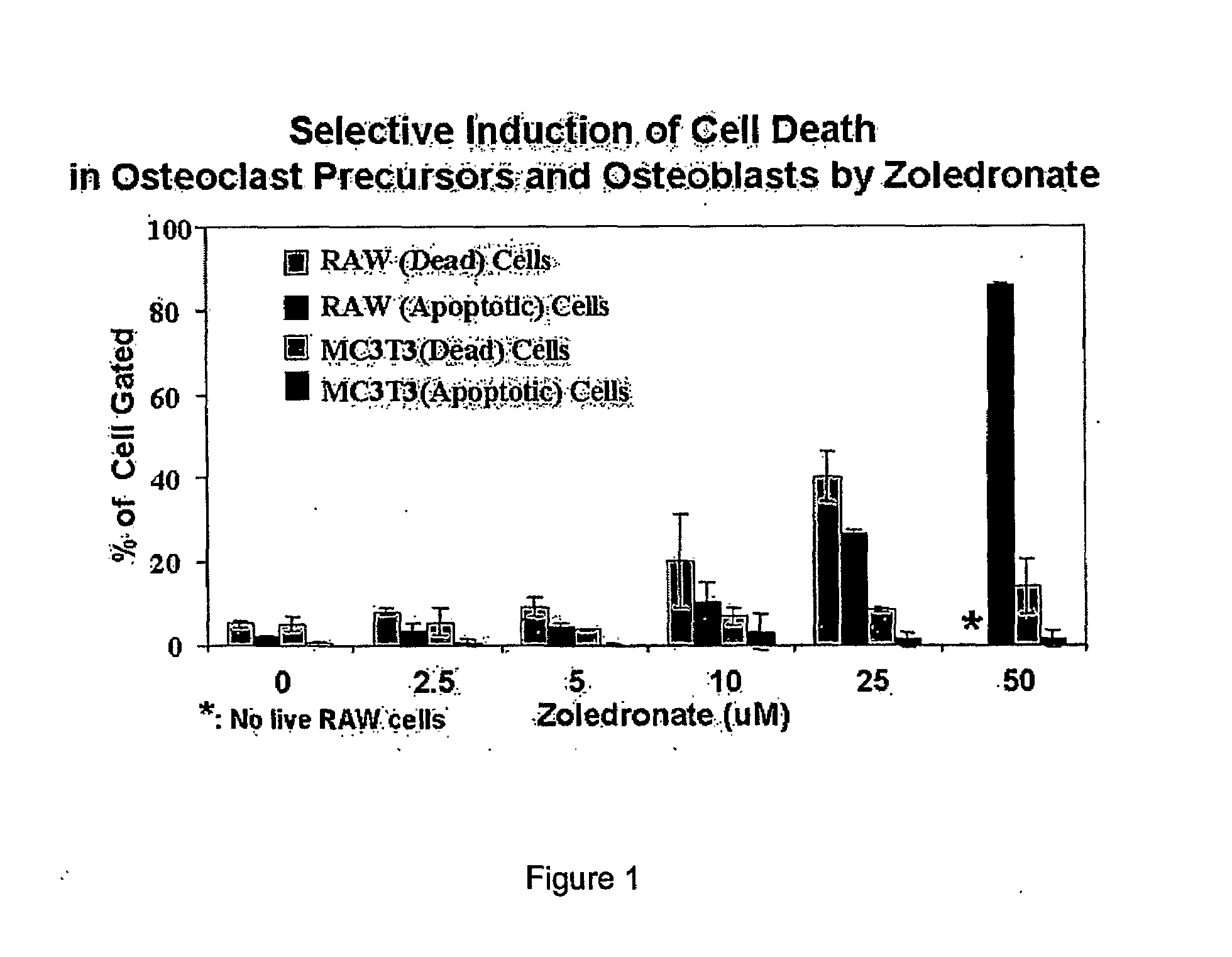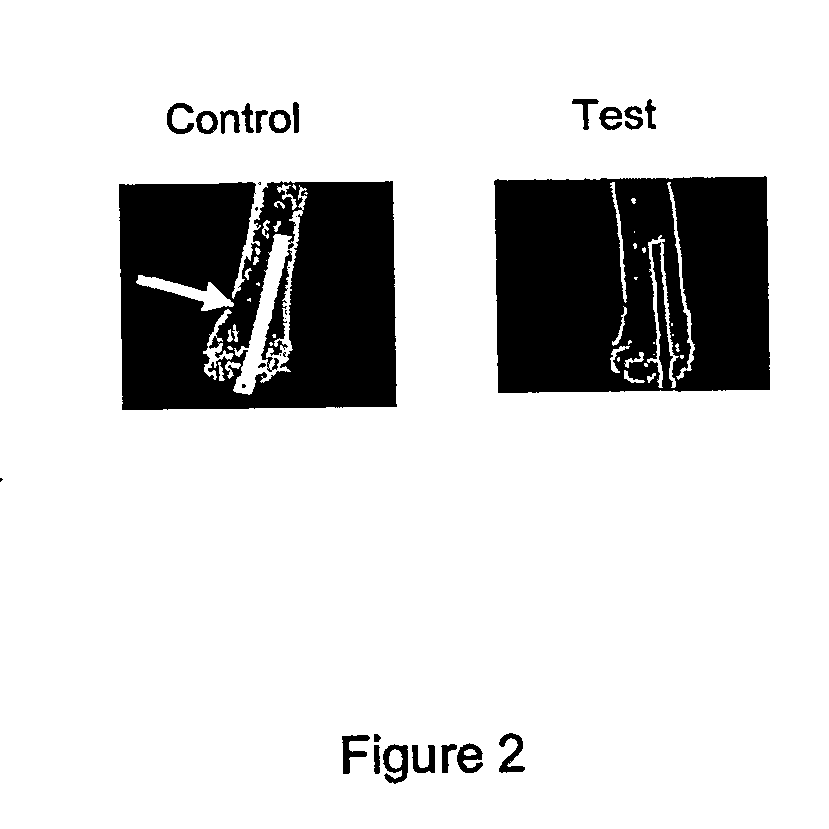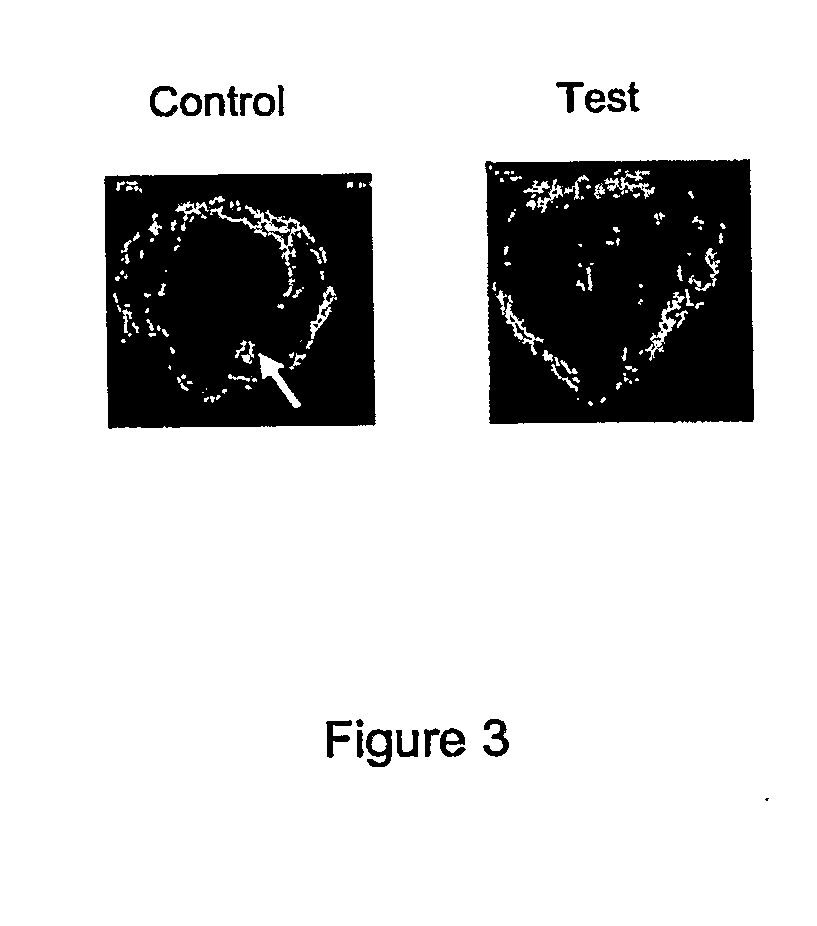Methods and Compositions for Improving the Incorporation of Orthopaedic and Orthodontic Implants
a technology for applied in the field of orthopaedic and orthodontic implants, can solve the problems of periprosthetic bone loss, aseptic loosening of implants, and certain polyethylene components of such implants, and achieve the effects of reducing osteolysis, and improving the incorporation of implants
- Summary
- Abstract
- Description
- Claims
- Application Information
AI Technical Summary
Benefits of technology
Problems solved by technology
Method used
Image
Examples
example 1
Determination of Optimal Zoledronate Concentration
[0055]A preliminary study was performed to determine an optimal concentration range of zoledronate for effectively reducing the pre-osteoclast population, while simultaneously having a less harmful effect on osteoblasts. Cell death assays were conducted using mouse osteoblasts and osteoclast precursor cells at different concentrations of zoledronate (Bedford Laboratories, OH).
[0056]MC3T3 cells, which are well-established mouse calvarial cells of osteoblastic lineage, and RAW 264.7 mouse macrophage-like cells, which are well-known to form osteoclasts, were purchased from the American Type Culture Collection and Tissue (Manassas, Va.). MC3T3 and RAW 264.7 cells were grown in Dulbecco's Modified Eagle Medium supplemented with 10% fetal bovine serum, 100 μ / mL penicillin, 100 mg / mL streptomycin, and 0.1% fungizone (amphotericin B). The cells were kept at 37° C. in a humidified atmosphere of 5% CO2 and 95% air.
[0057]After treating the cell...
example 2
First In Vivo Study
[0059]In this example, using a rodent osteolysis model, intramedullary femoral implants coated with effective amounts of zoledronate (a N-containing bisphosphonate) and hydroxyapatite were inserted into the femurs of rats. As shown below, the zoledronate- and hydroxyapatite-coated intramedullary implants were shown to reduce osteolysis adjacent to the implant site and to improve incorporation of the implant into the host bone.
[0060]More particularly, sterile ultrahigh molecular weight polyethylene (UHMWPE) wear debris particles (0.5 cc, 0.1-3 micron particle size) were introduced into the intramedullary cavity of bilateral femurs of 8 rats, which served as the control group in this example. The particles were introduced after reaming the femurs with an 18 gauge needle at the knee joint. Sterile wear debris particles were used in this example to stimulate a wear debris reaction and promote osteolysis. Hydroxyapatite-coated plastic pins and hydroxyapatite-coated tit...
example 3
Second In Vivo Study
[0066]Experimental Design and Surgical Procedure. In this example, a polyethylene particle-induced osteolysis rodent femur model was used to examine the advantages of using a HA-zoledronate composite on the implant surface for osseous integration and implant stability in the presence of UHMWPE particles. Two critical parameters were examined, namely, peri-implant bone quality (osteolysis) and osseointegration (implant stability).
[0067]All procedures involving animals were approved by the Institutional Animal Care and Use Committee in accordance with the Association for the Assessment and Accreditation of Laboratory Animal Care guidelines (Columbia University Animal Proctocol AC-AAM5306). In this example, a rodent femur intramedullary nailing model was used with UHMWPE wear debris particles instilled into the intramedullary canal after reaming the femur to stimulate a wear debris reaction. Thirty-two six-month-old adult male Sprague-Dawley rats (weight, 400-500 gm...
PUM
| Property | Measurement | Unit |
|---|---|---|
| particle size | aaaaa | aaaaa |
| concentration | aaaaa | aaaaa |
| vol. % | aaaaa | aaaaa |
Abstract
Description
Claims
Application Information
 Login to View More
Login to View More - R&D
- Intellectual Property
- Life Sciences
- Materials
- Tech Scout
- Unparalleled Data Quality
- Higher Quality Content
- 60% Fewer Hallucinations
Browse by: Latest US Patents, China's latest patents, Technical Efficacy Thesaurus, Application Domain, Technology Topic, Popular Technical Reports.
© 2025 PatSnap. All rights reserved.Legal|Privacy policy|Modern Slavery Act Transparency Statement|Sitemap|About US| Contact US: help@patsnap.com



